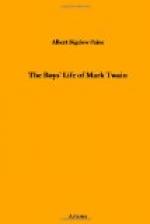He could gather items all day, and at night put down the day’s budget well enough, at least, to delight his readers. When he was tired of facts, he would write amusing paragraphs, as often as not something about Dan, or a reporter on a rival paper. Dan and the others would reply, and the Comstock would laugh. Those were good old days.
Sometimes he wrote hoaxes. Once he told with great circumstance and detail of a petrified prehistoric man that had been found embedded in a rock in the desert, and how the coroner from Humboldt had traveled more than a hundred miles to hold an inquest over a man dead for centuries, and had refused to allow miners to blast the discovery from its position.
The sketch was really intended as a joke on the Humboldt coroner, but it was so convincingly written that most of the Coast papers took it seriously and reprinted it as the story of a genuine discovery. In time they awoke, and began to inquire as to who was the smart writer on the “Enterprise.”
Mark Twain did a number of such things, some of which are famous on the Coast to this day.
Clemens himself did not escape. Lamps were used in the “Enterprise” office, but he hated the care of a lamp, and worked evenings by the light of a candle. It was considered a great joke in the office to “hide Sam’s candle” and hear him fume and rage, walking in a circle meantime—a habit acquired in the pilothouse—and scathingly denouncing the culprits. Eventually the office-boy, supposedly innocent, would bring another candle, and quiet would follow. Once the office force, including De Quille, McCarthy, and a printer named Stephen Gillis, of whom Clemens was very fond, bought a large imitation meerschaum pipe, had a German-silver plate set on it, properly engraved, and presented it to Samuel Clemens as genuine, in testimony of their great esteem. His reply to the presentation speech was so fine and full of feeling that the jokers felt ashamed of their trick. A few days later, when he discovered the deception, he was ready to destroy the lot of them. Then, in atonement, they gave him a real meerschaum. Such things kept the Comstock entertained.
There was a side to Samuel Clemens that, in those days, few of his associates saw. This was the poetic, the reflective side. Joseph Goodman, like Macfarlane in Cincinnati several years earlier, recognized this phase of his character and developed it. Often these two, dining or walking together, discussed the books and history they had read, quoted from poems that gave them pleasure. Clemens sometimes recited with great power the “Burial of Moses,” whose noble phrasing and majestic imagery seemed to move him deeply. With eyes half closed and chin lifted, a lighted cigar between his fingers, he would lose himself in the music of the stately lines:
By Nebo’s lonely mountain,
On this side Jordan’s wave,
In a vale in the land of Moab
There lies a lonely grave.
And no man knows that sepulcher,
And no man saw it e’er,
For the angels of God upturned the sod,
And laid the dead man there.




